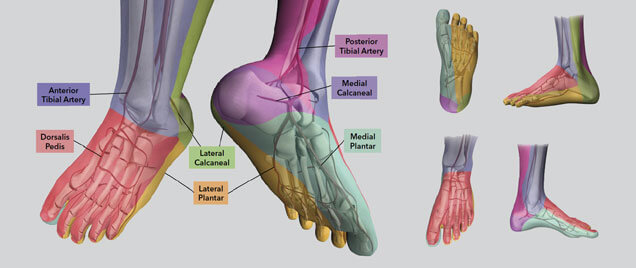The angiosome concept of perfusion delineates specific vascular territories that are supplied by specific arteries. The concept may help vascular interventionalists treat tissue defects caused by critical limb ischemia (CLI) by enabling the interventionalists to target arteries according to the location of foot ulcers.
The angiosome concept of perfusion was first described in 1987 by Taylor and Palmer.1 Treatment based on the angiosome concept can help wounds to heal and may preserve limbs.2,3 In a retrospective analysis, Alexandrescu et al gathered specific Wagner 1-4 diabetic foot ulcers in Rutherford category 5-6 ischemic limbs. They applied the angiosome concept in primary below-the-knee angioplasty for limb salvage. They reported complete healing of foot ulcers with or without minor limb amputation in 98 of 124 limbs,3 which is similar to preliminary results observed by others.2

Anterior tibial
The anterior tibial artery descends the front of the lower leg and becomes the dorsalis pedis artery, which transverses the ankle and dorsum of the foot.
Dorsalis pedis
The dorsalis pedis artery branches into the lateral and medial tarsal arteries—which supply blood to the side and middle of the foot, respectively—and continues to descend through the foot, where it becomes the arcuate artery, from which the dorsal metatarsal arteries extend. The dorsal metatarsal arteries become the dorsal digital arteries, which supply blood to the toes.
Lateral calcaneal
The lateral calcaneal artery is a terminal segment of the peroneal artery, which descends into the heel and supplies it with blood.
Lateral plantar
The lateral plantar artery descends through the foot and converges with the plantar arch, from which the plantar metatarsal arteries extend. The plantar metatarsal arteries become the plantar digital arteries, which supply blood to the toes.
Medial Calcaneal
The medial calcaneal artery (MCA) ascends from the posterior tibial artery (PTA) just before the PTA bifurcates into the lateral and medial plantar arteries. The MCA runs toward the back of the heel, where it converges with the lateral calcaneal artery and supplies blood to the heel.
Medial plantar
The medial plantar artery descends through the foot and converges with the first dorsal metatarsal artery. The first dorsal metatarsal artery bifurcates at the split between the first and second toes and supplies them with blood.
Posterior tibial
The posterior tibial artery descends the back of the lower leg, branches into the fibular artery, and continues toward the foot, where it bifurcates into the lateral and medial plantar arteries at the ankle.
1. Taylor GI, Palmer JH. The vascular territories (angiosomes) of the body: experimental study and clinical applications. Br J Plast Surg.1987;40(2):113-141.
2. Iida O, Nanto S, Uematsu M, et al. Importance of the angiosome concept for endovascular therapy in patients with critical limb ischemia.Catheter Cardiovasc Interv. 2010;75(6):830-836.
3. Alexandrescu VA, Hubermont G, Philips Y, et al. Selective primary angioplasty following an angiosome model of reperfusion in the treatment of Wagner 1-4 diabetic foot lesions: practice in a multidisciplinary diabetic limb service. J Endovasc Ther. 2008;15(5):580-593.